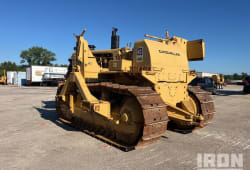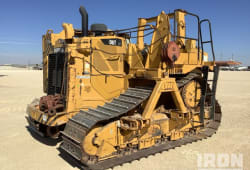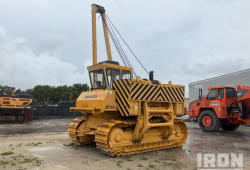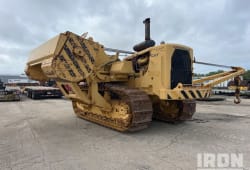A Comprehensive Guide of Pipelayers in Construction Projects
7 Min read
)
June 11, 2023
Pipelayers play an important role in construction projects. Particularly those involving the installation of underground pipelines for various purposes. These specialized machines are designed to grade trenches, seal joints, and position pipes. Pipelayers are instrumental in the construction such as water mains, oil and gas pipelines, and sanitation sewers.
In this comprehensive article, we will delve into the world of pipelayers. exploring these tools, their uses, and how they contribute to the success of construction projects.
What is a pipelayer?
Pipelayers are specialized construction machines used for the installation of pipelines in underground or trenching operations. These machines are designed to handle and position pipes of various sizes and materials, such as steel, concrete, cement, or plastic. The hydraulic systems control the lifting, lowering, and tilting of the pipes during installation.
There are various types of models of pipelayers but some most used pipelayers are Caterpillar PL61, Cat PL87, Cat PL61, and PL87. Volvo PL3005D, Volvo PL4611C, and Volvo PL4608C. Measuring, inspecting holes, and laying pipes are vital for installation and construction projects. Let's explore each of these processes:
Measuring: Accurate measurement is essential to ensure proper alignment and fit of the pipe sections. Measurements are taken to determine the correct length, diameter, and angles required for the pipeline. This step helps in determining the precise location for cuts, fittings, and connections.
Inspecting: Pipe inspection involves assessing the condition and quality of the pipes before installation. This includes examining for any defects, corrosion, or damage that may impact the pipe's integrity. An inspection ensures that only high-quality tubes are used, minimizing the risk of future leaks or failures.
Laying Pipe: Laying pipe involves positioning the pipes in the designated trench or underground space. This requires the use of specialized equipment, such as pipelayers. It helps to maintain and place the pipes. Proper grade and connection of the pipes are vital for structural integrity and functionality.
measuring, inspecting, and laying pipes are critical steps in pipeline construction. They contribute much value to the efficiency, longevity, and reliability of the pipeline. Make sure that it meets the required standards and performs in its intended application.
Job requirements for pipelayers
The job requirements for pipelayers include a combination of skills, qualifications, and physical abilities. Here are some common requirements for pipelayer positions: Experience in pipeline installation or related construction work.
Physical fitness and ability to handle demanding tasks. Skill in reading blueprints and plans. Knowledge of safety practices and adherence to regulations. Familiarity with operating construction equipment.
Effective communication and teamwork skills. Valid driver's license for transportation. Relevant certifications or training as required. Requirements may vary based on the employer and project specifications. Refer to job postings for specific details.
What is the difference between a pipelayer and a side boom?
A pipelayer is used for handling and laying pipes during pipeline construction. It is specialized equipment for pipe transportation and aiding in positioning and preparing pipes for welding or connection.
Benefits of Pipelayers
:format(webp))
Pipelayers offer several benefits in the construction industry. Some of the key advantages include:
1. Efficient Pipe Handling
Pipelayers streamline the process of handling pipes. It enables quick and precise positioning in trenches or underground spaces. This efficiency saves time and labor, increasing productivity.
2. Accurate Pipe Placement
With their specialized boom and hydraulic controls, pipelayers ensure accurate alignment and placement of pipes. This helps in achieving proper connections, reducing the risk of leaks and future maintenance issues.
3. Enhanced Safety
Pipelayers are designed with safety features such as stability systems and operator controls. It has increased productivity and provides a secure working environment. These features cut the risk of accidents during pipe handling and installation.
4. Versatility
Pipelayers can handle a wide range of pipe sizes and materials. It has made them versatile for various construction projects. They can accommodate pipes made of steel, concrete, or plastic. It helps to provide flexibility in pipeline installations.
5. Increased Productivity
By mechanizing the pipe handling process, pipelayers contribute to increased productivity. They end the need for manual lifting and positioning, allowing workers to focus on other critical tasks.
6. Precise Grade and Alignment
Pipelayers make accurate grades and alignment of pipes, facilitating the smooth flow of fluids or materials through the pipeline. This precision contributes to the functionality and efficiency of the pipeline system.
7. Long-Term Reliability
installed pipelines using pipelayers are more likely to have long-term reliability. The precise alignment and connections reduce the risk of leaks, failures, and costly repairs in the future.
The use of pipelayers has many benefits, including improved efficiency, safety, and productivity.
Role of Pipe Layers in the Construction Projects
Pipelayers play a critical role in the construction industry. In projects involving the installation of underground pipelines. These versatile machines are designed to perform and grade trenches, and seal joints. It has contributed to the successful completion of various infrastructure projects. It has also contributed to water supply networks, sewer systems, and gas pipelines.
Efficient Trench Grading
Pipelayers are equipped with specialized attachments and hydraulically-operated booms. It allows them to grade trenches and this ensures that the trench dimensions meet the required specifications. By promoting the proper positioning and alignment of the pipes.
Accurate Pipe Placement
Positioning pipes is crucial to ensuring the integrity and functionality of the pipeline system. Pipelayers use their robust structures and hydraulic capabilities to lift and position pipe. This precision reduces the risk of damage to the pipes during installation and helps maintain them.
Effective Joint Sealing
Proper welding equipment is vital for pipeline durability and preventing leaks. Pipelayers often feature integrated systems that help the application of sealants and coatings. Make sure to secure watertight connections between pipe sections. This promotes the longevity and efficiency of the pipeline system.
Contributing to Sanitation Sewers
In sanitation sewer projects, pipelayers are essential for the installation of underground sewer lines. They handle the heavy lifting and positioning of large-diameter pipes. Which is required for effective wastewater management. The accuracy and precision of pipelayers ensure that sewer lines are laid. avoiding future operational and maintenance issues.
Versatile Machines
Pipelayers are versatile machines that can adapt to various project requirements. They can handle different pipe sizes, types, and materials. Which allows flexibility in construction projects. Their adaptability makes them suitable for a wide range of applications. Their applications are from municipal infrastructure projects to oil and gas pipeline installations.
In conclusion, pipelayers are indispensable machines in construction projects involving underground pipelines. Their ability to grade trenches, position pipes, seal joints, and contribute to the installation of sanitation sewers makes them crucial for the successful completion of infrastructure projects.
Is being a pipe layer an excellent job?
If you are a high school diploma holder and you will able to lay pipe for construction projects then this job is for you. Occupations of a pipelayer can be fulfilling and rewarding jobs for individuals or employers. Because those who enjoy working in the construction industry have a specific interest in underground pipeline installations. It offers opportunities for skill development, hands-on work, and satisfaction.
the average annual salary for a pipelayer operator ranges from $35,000 to $70,000, with variations based on these factors. It's important to note that salaries can differ from one region to another due to local market conditions and the demand for skilled labor.
Component of pipelayers | Parts
A pipelayer consists of several key components that work together to help the efficient and precise installation of pipelines. These components include:
Chassis: The main framework that provides stability and support. Boom: Hydraulic arm used for lifting and positioning pipes.
Counterweight: Balances the weight of the boom and pipe loads. Operator Cabin: Enclosed space for the operator to control the
Track System: Provides traction and mobility on various terrains.
Winch: Pulls and positions pipes during installation.
Pipe Holding Attachments: Grips and secures the pipes during transport and placement.
Controls and Instrumentation: Panel with controls and gauges for operating the pipelayer.
Engine: Provides power for the machine's operations.
Hydraulic System: Powers the various hydraulic functions, such as lifting and tilting the boom.
Conclusion
In conclusion, pipelayers are indispensable machines in construction projects. It involves the installation of underground pipelines. Their ability to grade trenches, position pipes, seal joints, and contribute to the installation. Make them crucial for the successful completion of infrastructure projects.
The average annual salary for a pipelayer operator ranges from $35,000 to $70,000, depending on factors such as location and demand for skilled labor. pipelayers play a vital role in ensuring the efficient and effective construction of pipeline systems. It contributes to the development of vital infrastructure for various sectors.















